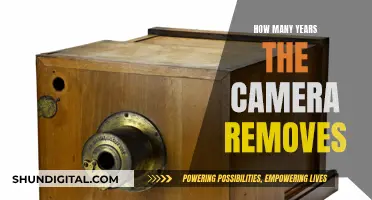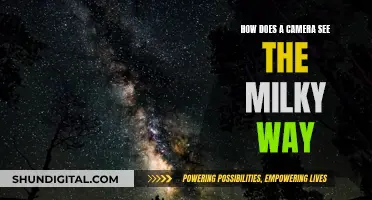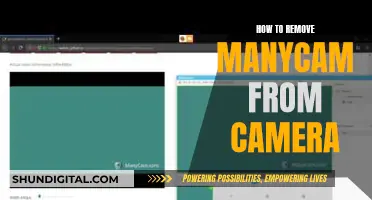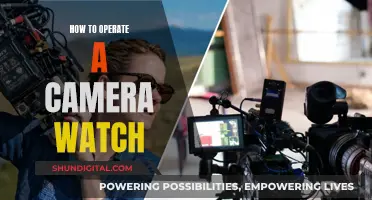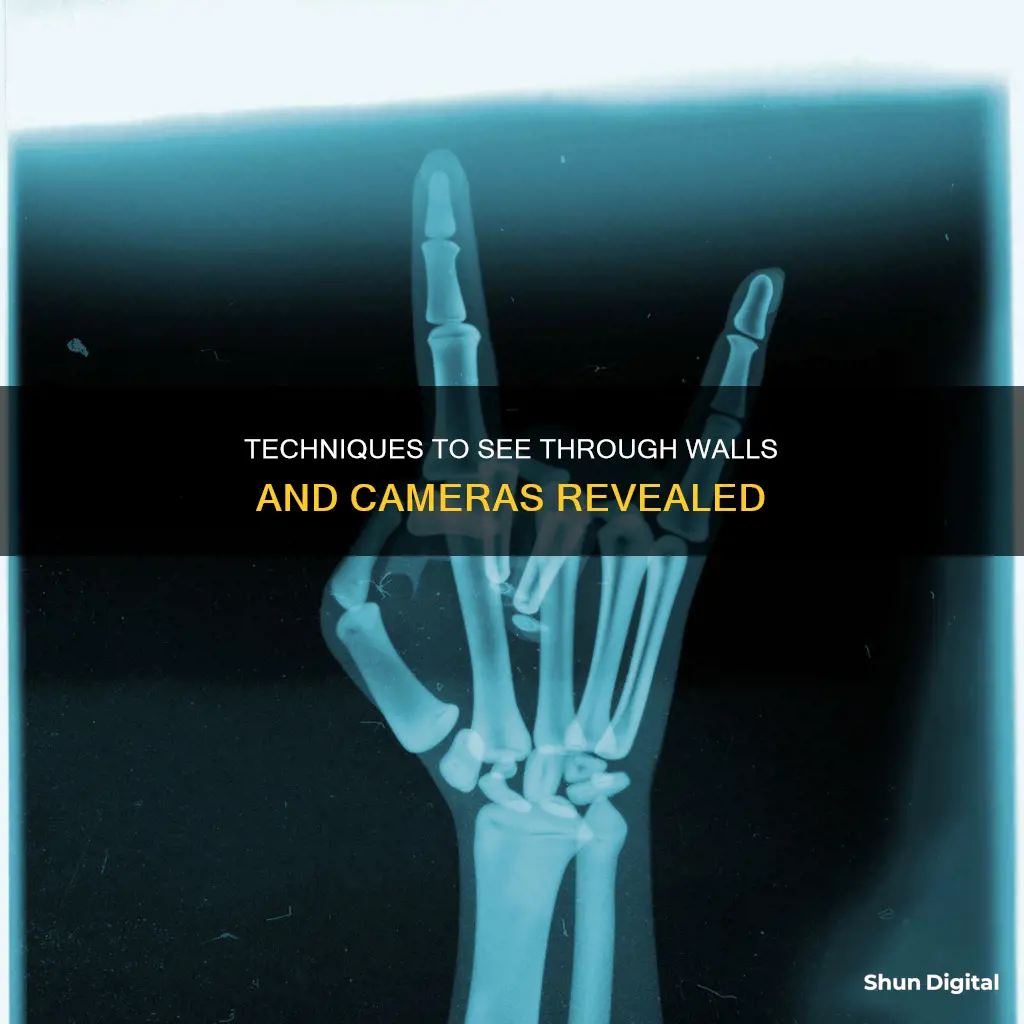
The idea of seeing through walls has captivated people since ancient times. While it is not possible to see through walls with the naked eye, technological advancements have made it possible to use certain devices for this purpose. One such device is a thermal imaging camera, which detects heat signatures radiating through solid objects like walls. These cameras can identify heat sources such as pipes, wires, and ducts, and are useful for detecting leaks, blockages, and insulation issues. Another method for seeing through walls involves the use of radio waves, which can penetrate walls and sense the presence of people or objects on the other side. While radio waves don't provide visual images, they can be used to create 2D or 3D representations of what's behind a wall. These techniques have been utilised by government agencies, military forces, and law enforcement for surveillance, intelligence gathering, and search and rescue operations.
| Characteristics | Values |
|---|---|
| Technology | Through-Wall Imaging |
| History | The history of spying dates back to the earliest days of civilization. The Stasi, the secret police of East Germany, monitored their citizens by drilling holes in walls and filming through them. |
| Previous Methods | Inserting fiber optics through walls, using thermal imaging with IR cameras, and radio waves have all been attempted in the past but come with limitations. |
| Breakthrough | The invention and implementation of ultra-wideband (UWB) radars, which operate at low frequencies and use a wide bandwidth, allowing penetration without sacrificing resolution. |
| Current Devices | XaverTM100, XaverTM400, and XaverTM800 are examples of devices that use UWB technology to provide imaging capabilities and detect movement behind walls. |
| Limitations | The total depth a thermal camera can see is limited, and interpretation of imaging by skilled thermographers is required for accurate diagnostics. |
| Applications | Military, law enforcement, intelligence agencies, and search and rescue operations. |
What You'll Learn

Radio waves can pass through walls
The size of a radio wave compared to a wall means it can pass through. However, as the wall gets bigger or thicker, there are more atoms for the radio wave to interact with, and it will not pass through as easily.
Radio waves have been used to 'see through walls' since the 1960s, when research was carried out into their potential for this purpose. Radio waves are highly effective at penetrating walls, but this does not mean that you can see through walls. However, it was the first step in using radio waves to sense people on the other side of a wall.
The challenge of seeing through walls has been so difficult that, until recently, it was only possible to get some indications of what is happening on the other side. For example, the presence of people could be detected by picking up on small vital life movements, such as breathing.
A breakthrough was achieved with the invention of ultra-wideband (UWB) radars, which operate in relatively low frequencies while using a very wide bandwidth. This allows for penetration capabilities without sacrificing resolution. The first UWB radar was introduced in the early 1970s, and the first fielded system that enabled operators to detect people's movements through walls was developed in the 1990s.
Today, there are devices that provide a comprehensive view behind a wall, such as the XaverTM800, which is a full 3D imaging device. However, there are still some physical limitations, and it is unlikely that we will ever be able to truly 'see through walls' and get super-realistic images.
Visio TV Camera: How to Spot It
You may want to see also

Thermal cameras detect heat signatures
Thermal cameras, also known as infrared thermal imaging cameras, are a powerful tool for seeing through certain obstacles and detecting objects that emit heat. They are widely used in various industries, including law enforcement, firefighting, energy auditing, outdoor night vision, and construction.
Thermal cameras capture the infrared radiation emitted by objects, which is then processed and translated into a visual image. This technology is particularly useful for identifying heat signatures, which can provide valuable information in various scenarios.
Applications of Heat Signature Detection
Law Enforcement and Surveillance
Thermal imaging is commonly used by government agencies and law enforcement to monitor individuals and gather information in low-light conditions or where traditional cameras are ineffective due to darkness or excessive ambient light. Thermal cameras can detect heat signatures inside buildings, track human or animal presence, and identify potential intruders or trespassers.
Firefighting and Search and Rescue
Firefighters use thermal cameras to locate people trapped in burning buildings. The ability to detect heat signatures and create a thermal profile of an area is crucial for search and rescue operations, especially in low-visibility conditions.
Building Maintenance and Energy Auditing
In building maintenance, thermal cameras are employed to detect heat loss due to poor insulation or air leaks. They can also identify water leaks within walls or beneath floors, making them valuable tools for energy auditors and building inspectors.
Identifying Hidden Cameras
While not always effective, thermal cameras can sometimes detect hidden cameras, especially if they have been operating for a while and have generated heat. Additionally, if the hidden camera has heat-emitting components, such as a battery or a motor, the thermal camera may be able to pick up its heat signature.
Medical and Veterinary Applications
In the medical and veterinary fields, thermal imaging cameras can detect changes in body temperature, aiding in the early detection of various health conditions, such as breast cancer.
Industrial Inspections and Preventive Maintenance
Thermal imaging plays a crucial role in industrial inspections by detecting overheating components, insulation failures, and potential equipment malfunctions. This helps enhance operational efficiency, safety, and cost savings by enabling early identification of issues.
Limitations and Ethical Considerations
It is important to note that thermal cameras have limitations and cannot "see" through all materials. Most walls, for example, have poor thermal conductivity, which can hinder the effectiveness of thermal imaging in certain scenarios.
Additionally, the use of thermal imaging for surveillance raises civil liberty concerns. Privacy advocates have highlighted the potential for government agents to misuse this technology to gather information on individuals based on their political or religious views or to conduct dragnet surveillance on private residences.
Stream Reolink Camera to Vizio TV: Easy Steps
You may want to see also

Stasi's method of drilling holes in walls
Stasis Drilling Solutions is a privately held oilfield service company incorporated in Bossier City, Louisiana, with a corporate office in Houston, Texas. Stasis aims to revolutionise the way wells are drilled by utilising Managed Pressure Drilling (MPD) technology, expertise, and safety, all while maintaining the highest level of quality and service.
The company's MPD philosophy involves a thorough review of each drilling program, including an initial analysis of the project's operational and technical objectives to determine the feasibility of MPD in addressing the issue. This is followed by a detailed step-by-step plan that covers well pressure profiles, optimisation of mud, casing, and cementing programs, tripping plans, and contingency procedures.
Stasis offers a range of engineering services to support their clients throughout the entire MPD process. These services include 24/7 remote technical support, onsite MPD project supervision and engineering, MPD equipment integration plans, customer training, and hazard analysis.
The STASIS Hornet MPD Manifold is a key component of their drilling technology. It controls returns from the wellbore, enabling precise pressure management during well construction. The STASIS IMPACCT™ control system further enhances operational efficiency by providing automated control of the managed pressure drilling process.
Stasis Drilling Solutions is committed to advancing the drilling industry by prioritising safety, reducing costs, and delivering Best-in-Class services to its clients.
Exploring Apple TV: Viewing Camera Feeds
You may want to see also

Using fibre optics to see through walls
Fibre optics is a means of transmitting information using light beams and thin strands of plastic or glass. This technology was originally developed for endoscopes in the 1950s to help doctors visualise the insides of a patient's body without having to perform surgery.
A fibre-optic cable is made up of incredibly thin strands of glass or plastic, known as optical fibres. Each strand is thinner than a human hair and can carry about 25,000 telephone calls.
Light travels down a fibre-optic cable by bouncing off the walls of the cable in a process known as total internal reflection. This phenomenon occurs when light hits glass at a shallow angle, causing it to reflect back as though the glass were a mirror.
The structure of the cable consists of two parts: the core and the cladding. The core is the central part of the cable through which light travels. The cladding is a layer of glass wrapped around the core that serves to keep the light signals inside.
There are two types of fibre-optic cables: single-mode and multi-mode. Single-mode fibres have a very thin core, and the light signals travel straight down the middle without bouncing off the edges. Multi-mode fibres are about ten times thicker, allowing light to travel through the core by following different paths and bouncing at various angles.
Fibre-optic cables offer several advantages over traditional copper cables:
- Less attenuation: Information can travel about ten times further before needing amplification, making fibre networks simpler and cheaper to maintain.
- No interference: Fibre-optic cables do not experience "crosstalk" or electromagnetic interference, resulting in more reliable and higher-quality signal transmission.
- Higher bandwidth: Fibre-optic cables can carry far more data than copper cables of the same diameter.
Fibre-optic technology has become integral to various fields, including telecommunications, broadcasting, medical scanning, and military equipment. In terms of seeing through walls, fibre optics can be utilised for structural monitoring and detection of disturbances. For example, distributed fibre-optic sensing systems can detect human footsteps and are used for monitoring bridges, rails, pipelines, and aircraft structures.
Additionally, fibre-optic cables can be used for intrusion detection and border security. These cables can be discreetly buried or placed along existing infrastructure, and they can accurately detect and locate any breaches or cuts in the fibre. This information can then be used to dispatch border patrol agents and apprehend any unauthorised individuals crossing the border.
Fibre-optic technology offers a cost-effective and versatile solution for various applications, including enhancing security and monitoring structures. By utilising fibre optics, it is possible to gain valuable insights and effectively "see" through walls and other obstacles.
Smart TV Camera: Where is it Located?
You may want to see also

UWB radar technology
Ultra-Wideband (UWB) technology is an increasingly popular method for seeing through walls and other opaque media. UWB radar systems are particularly useful for detecting and localising human bodies, and have applications in military operations, disaster relief, elderly care, and more.
How UWB Radar Works
UWB radar systems work by transmitting signals with a minimum bandwidth of 500 MHz or a fractional bandwidth of at least 20%. The large bandwidth of UWB radar systems results in high range resolution, which helps to separate multiple targets.
UWB radar uses a combination of lower and higher frequencies, which allows it to penetrate building materials such as concrete and foliage. The optimal frequency range for conducting rescue activities in ruins and concrete buildings is 0.8 to 2 GHz.
Applications of UWB Radar Technology
Military and Disaster Relief
Elderly Care
Other Applications
Other applications of UWB radar technology include:
- Contactless respiratory and heart rate detection
- Multiple-target detection and localisation in a static environment
- Human gait analysis
- People counting
Spot Hidden Cameras: Detecting Cameras Behind Mirrors
You may want to see also
Frequently asked questions
No, standard smartphones cannot see through walls. However, a smartphone equipped with a thermal imaging camera can help visualise what’s behind a wall, such as wall studs and heating ductwork.
Yes, specialised devices using radar or thermal imaging can detect structures or heat sources through walls.
No, thermal cameras cannot see through walls or concrete. However, if there is a hot or cold pipe within the wall, it’s likely a thermal camera will pick up on this.
Thermal cameras contain heat sensors that detect subtle temperature changes. The sensors translate these thermal readings into visible light to display detailed temperature data overlaid onto real images.
While the human eye sees visible light reflected off objects, thermal cameras detect the infrared radiation emitted by heat sources. This allows thermal cameras to “see” temperature variations through dust, fog, smoke, thin walls, glass, fabric, and even some metals.


